
Mehmed II, commonly known as Mehmed the Conqueror, was an Ottoman sultan who ruled from August 1444 to September 1446, and then later from February 1451 to May 1481. In Mehmed II's first reign, he defeated the crusade led by John Hunyadi after the Hungarian incursions into his country broke the conditions of the truce Peace of Szeged. When Mehmed II ascended the throne again in 1451 he strengthened the Ottoman navy and made preparations to attack Constantinople. At the age of 21, he conquered Constantinople and brought an end to the Byzantine Empire.
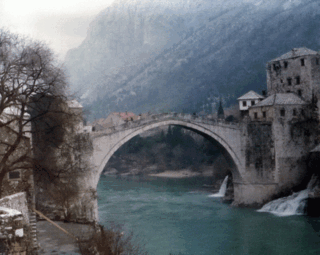
Year 1566 (MDLXVI) was a common year starting on Tuesday of the Julian calendar.

James Howell was a 17th-century Anglo-Welsh historian and writer who is in many ways a representative figure of his age. The son of a Welsh clergyman, he was for much of his life in the shadow of his elder brother Thomas Howell, who became Lord Bishop of Bristol.

Cem Sultan or Sultan Cem, was a claimant to the Ottoman throne in the 15th century.

Pierre d'Aubusson was a Grand Master of the Order of Saint John of Jerusalem, and a zealous opponent of the Ottoman Empire.

The second siege of Krujë took place from 1466 to 1467. Sultan Mehmed II of the Ottoman Empire led an army into Albania to defeat Skanderbeg, the leader of the League of Lezhë, which was created in 1444 after he began his war against the Ottomans. During the almost year-long siege, Skanderbeg's main fortress, Krujë, withstood the siege while Skanderbeg roamed Albania to gather forces and facilitate the flight of refugees from the civilian areas that were attacked by the Ottomans. Krujë managed to withstand the siege put on it by Ballaban Badera, sanjakbey of the Sanjak of Ohrid, an Albanian brought up in the Ottoman army through the devşirme. By 23 April 1467, the Ottoman army had been defeated and Skanderbeg entered Krujë.

The siege of Rhodes of 1522 was the second and ultimately successful attempt by the Ottoman Empire to expel the Knights of Rhodes from their island stronghold and thereby secure Ottoman control of the Eastern Mediterranean. The first siege in 1480 had been unsuccessful.

In 1480 the small Knights Hospitaller garrison of Rhodes withstood an attack of the Ottoman Empire.

Gjergj Kastrioti, known as Skanderbeg, was an Albanian feudal lord and military commander who led a rebellion against the Ottoman Empire in what is today Albania, North Macedonia, Greece, Kosovo, Montenegro and Serbia.
The Morean War, also known as the Sixth Ottoman–Venetian War, was fought between 1684–1699 as part of the wider conflict known as the "Great Turkish War", between the Republic of Venice and the Ottoman Empire. Military operations ranged from Dalmatia to the Aegean Sea, but the war's major campaign was the Venetian conquest of the Morea (Peloponnese) peninsula in southern Greece. On the Venetian side, the war was fought to avenge the loss of Crete in the Cretan War (1645–1669). It happened while the Ottomans were entangled in their northern struggle against the Habsburgs – beginning with the failed Ottoman attempt to conquer Vienna and ending with the Habsburgs gaining Buda and the whole of Hungary, leaving the Ottoman Empire unable to concentrate its forces against the Venetians. As such, the Morean War was the only Ottoman–Venetian conflict from which Venice emerged victorious, gaining significant territory. Venice's expansionist revival would be short-lived, as its gains would be reversed by the Ottomans in 1718.
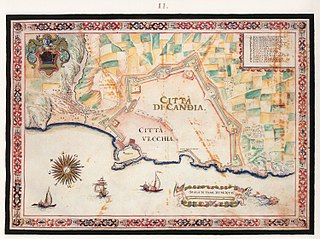
The Cretan War, also known as the War of Candia or the Fifth Ottoman–Venetian War, was a conflict between the Republic of Venice and her allies against the Ottoman Empire and the Barbary States, because it was largely fought over the island of Crete, Venice's largest and richest overseas possession. The war lasted from 1645 to 1669 and was fought in Crete, especially in the city of Candia, and in numerous naval engagements and raids around the Aegean Sea, with Dalmatia providing a secondary theater of operations.

The First Ottoman–Venetian War was fought between the Republic of Venice and her allies and the Ottoman Empire from 1463 to 1479. Fought shortly after the capture of Constantinople and the remnants of the Byzantine Empire by the Ottomans, it resulted in the loss of several Venetian holdings in Albania and Greece, most importantly the island of Negroponte (Euboea), which had been a Venetian protectorate for centuries. The war also saw the rapid expansion of the Ottoman navy, which became able to challenge the Venetians and the Knights Hospitaller for supremacy in the Aegean Sea. In the closing years of the war, however, the Republic managed to recoup its losses by the de facto acquisition of the Crusader Kingdom of Cyprus.
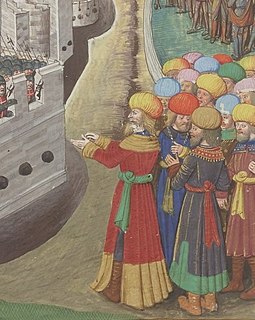
Mesih Pasha or Misac Pasha was an Ottoman of Eastern Roman origin, being a nephew of the last Roman emperor, Constantine XI Palaiologos. He served as Kapudan Pasha of the Ottoman Navy and was Grand Vizier of the Ottoman Empire in 1501.
Turahanoğlu Ömer Bey was an Ottoman general and governor. The son of the famed Turahan Bey, he was active chiefly in southern Greece: he fought in the Morea against both the Byzantines in the 1440s and 1450s and against the Venetians in the 1460s, while in 1456, he conquered the Latin Duchy of Athens. He also fought in Albania, north-east Italy, Wallachia and Anatolia.

The siege of Corfu took place on 8 July – 21 August 1716, when the Ottoman Empire besieged the city of Corfu, on the namesake island, then held by the Republic of Venice. The siege was part of the Seventh Ottoman–Venetian War, and, coming in the aftermath of the lightning conquest of the Morea by the Ottoman forces in the previous year, was a major success for Venice, representing its last major military success and allowing it to preserve its rule over the Ionian Islands.
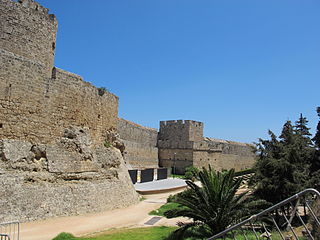
The fortifications of the town of Rhodes are shaped like a defensive crescent around the medieval town and consist mostly of a modern fortification composed of a huge wall made of an embankment encased in stone, equipped with scarp, bastions, moat, counterscarp and glacis. The portion of fortifications facing the harbour is instead composed of a crenellated wall. On the moles, towers and defensive forts are found.
Tomaso Schiavo or Thomaso Schiavo di Lebano was a Venetian Dalmatian captain and mercenary commander that participated in the Ottoman–Venetian War (1463–79). He commanded a mercenary unit numbering 500 men largely recruited from Dalmatia. During the 1470 Ottoman siege of Venetian Negroponte the Venetians uncovered that he had sent envoys to the Ottomans; a deep conspiracy was unearthed and Schiavo's associates were arrested. His brother was tortured to death, giving up plans of an Ottoman attack. Schiavo, unknowing, was summoned by Erizzo and then killed.
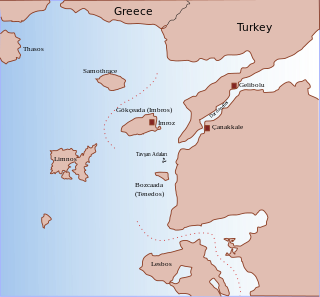
The Battle of Gallipoli occurred on 29 May 1416 between a squadron of the Venetian navy and the fleet of the Ottoman Empire off the Ottoman naval base of Gallipoli. The battle was the main episode of a brief conflict between the two powers, resulting from Ottoman attacks against Venetian possessions and shipping in the Aegean Sea in late 1415. The Venetian fleet, under Pietro Loredan, was charged with transporting Venetian envoys to the Sultan, but was authorized to attack if the Ottomans refused to negotiate. The subsequent events are known chiefly from a letter written by Loredan after the battle. The Ottomans exchanged fire with the Venetian ships as soon as the Venetian fleet approached Gallipoli, forcing the Venetians to withdraw.
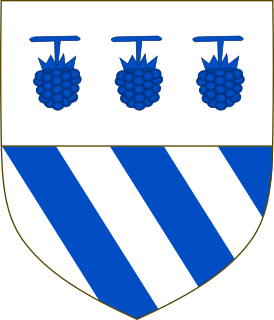
The House ofMòro is a patrician family of the Republic of Venice and one of the founding families of the city in 421.

Guillaume Caoursin, also called Gulielmus Caoursin, was vice-chancellor of the Order of Saint John of Jerusalem, or Knights Hospitaller. He was an eye-witness to the siege of Rhodes in 1480, an unsuccessful attack on the Hospitaller garrison led by Pierre d'Aubusson by an Ottoman fleet of 160 ships and an army of 70,000 men under the command of admiral Mesih Pasha.



















